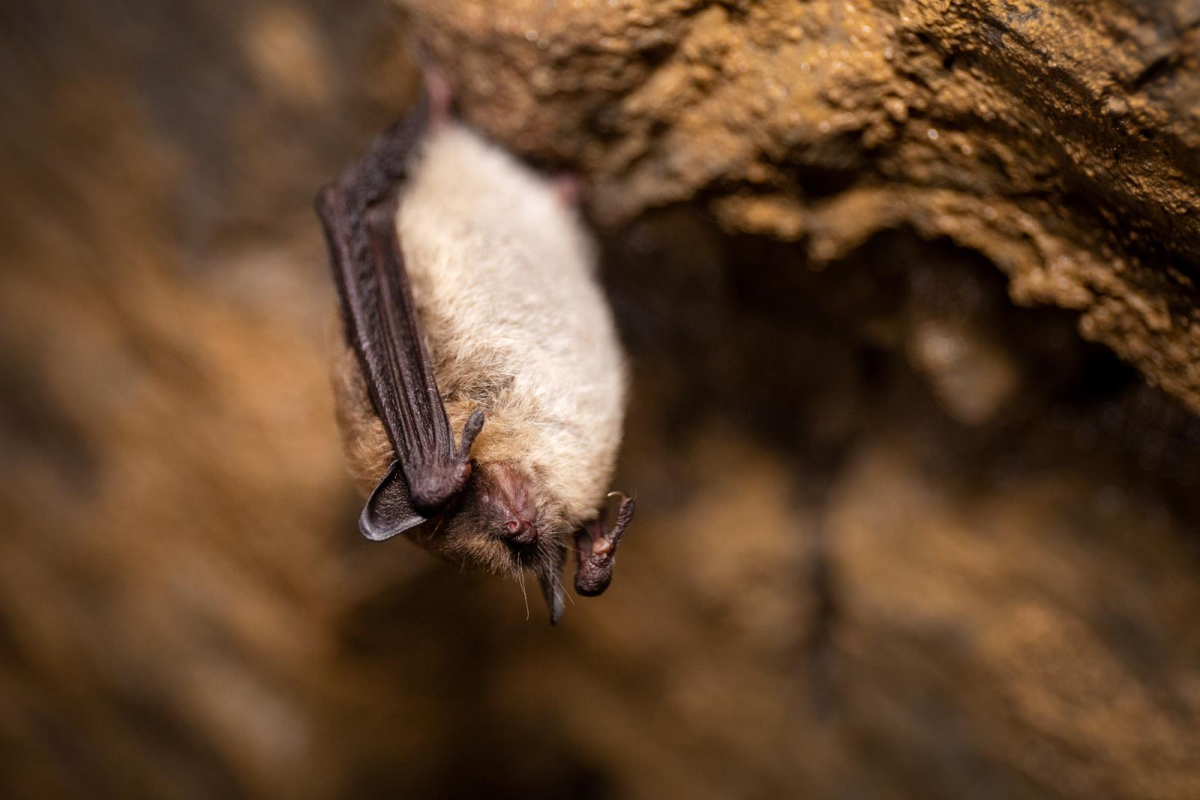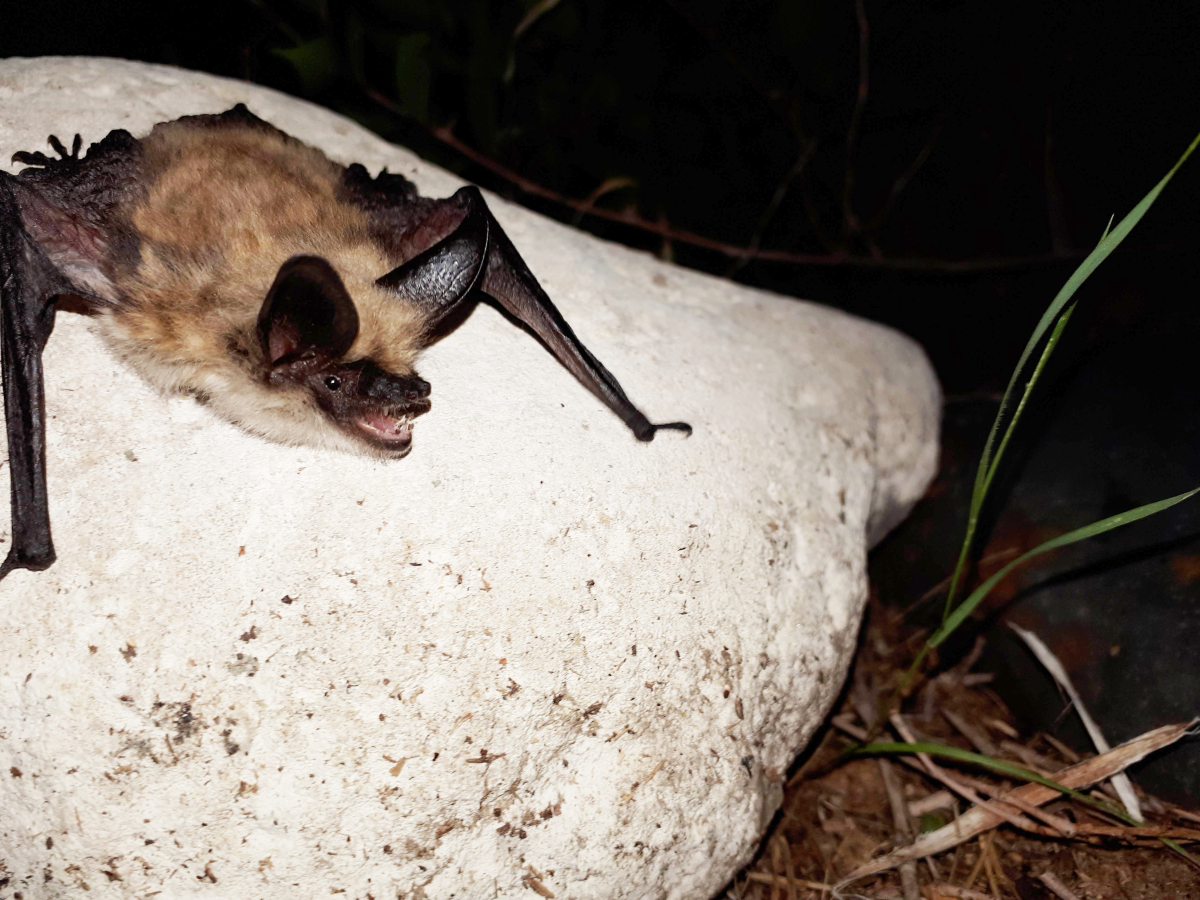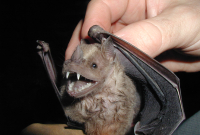Support strong Canadian climate journalism for 2025
It was the news scientists had been dreading but had a strong hunch was coming: The fungus that causes deadly white-nose syndrome in bats had been officially confirmed in Alberta.
Samples collected through an innovative monitoring program led by Wildlife Conservation Society Canada turned up positive results in late 2022, confirming a more than 500-kilometre westward jump in the known presence of this non-native fungus, which has already spelled catastrophe for many bat populations in eastern North America, with declines of more than 90 per cent for affected species.
The situation risks harm to both ecosystems and the economy. All bats in Canada eat nothing but bugs — mostly insects that fly at night. Bats play a critical role in keeping ecosystems healthy by regulating insect populations, some of which are major threats to plants and animals. One estimate is that bats provide $3.7 billion to $53 billion worth of pest control services each year to the U.S. agricultural sector.
The fungus Pseudogymnoascus destructans (more simply referred to as Pd) is the root cause of white-nose syndrome (WNS). Pd grows on bats during their winter hibernation and penetrates wing membranes and other exposed skin. These skin injuries cause bats to wake from hibernation more frequently, using up critical fat reserves in winter. Depletion of energy stores eventually leads to starvation and death for infected bats.
The diligent work and support of our many university, government and community partners allowed us to collect guano (poop) samples from locations across Western Canada, particularly at bridges that cross rivers.
Bats are known to travel and feed extensively along rivers, resting under bridges, so the appearance of bat guano there was no surprise. But until we began our project, most of us didn’t appreciate just how often bridges in Canada are used by bats. (It turns out, it’s often!)
We surveyed more than 800 bridge sites across Western Canada and were able to collect guano from about half these locations. These samples were sent to a lab for Pd testing along with additional samples collected at buildings and bat houses.
We knew that Pd was spreading West thanks to detections in Manitoba and our 2021 detections in Saskatchewan. Now we have confirmation of it being found along the Red Deer River in Alberta, not far from Dinosaur Provincial Park. This is particularly alarming because the unique geological features of the “badlands” terrain along some stretches of this river and its tributaries create numerous cracks and crevices that provide sites in summer for bats to raise their offspring and in winter, for multiple species to hibernate.
We already know that multiple bat species hibernate along the Red Deer River, and the badlands, in particular, represent the largest known hibernation area for bats in Alberta. Equally worrying is that the Red Deer River provides a migration corridor into the Canadian Rockies where bats are also known to hibernate.
The only bright side to this news is that we have seen this moment coming for some time now and have been working hard with governments, other conservation organizations and citizens to prepare for its arrival.
Right now, there is no effective “cure” or treatment for WNS, but WCS Canada, along with partners, is testing a protective measure that might reduce the severity of WNS. This “probiotic,” which arms bats with beneficial wing microbes to keep Pd from growing, is being field tested in Washington state (where WNS is present) and in southwestern B.C. Bats could be inoculated at their summer roosting sites (like bridges) and then the bats themselves could help spread the beneficial microbes (which already naturally occur on a small number of some species of bats), meaning that inoculating a few bats could lead to large-scale benefits. If this proves effective, we may be able to adapt it for use in Alberta.
Most importantly, we have been drawing attention to the urgent need to improve how bats are being managed by industry, government and homeowners. Our work over the last few years has shown that most bat sightings in buildings and at bridges were little brown bats, which is one of the species most impacted by WNS.
In some areas, buildings appear to account for most of the sites where this species raises offspring. Ensuring bat-friendly management approaches are used when bats occupy human structures is one of the most important things we can do to help bats. Ensuring healthy environments, especially wetlands and riparian areas, is critical for bats to have access to food and drinking water.
We are working to provide free training to everyone from pest control companies to farmers on how to help bats while addressing public misperceptions about these fascinating and long-lived creatures (which are a lot closer to flying grizzly bears than flying mice, given their long life histories).
Bats that hibernate on the Canadian Prairies only give birth to one offspring (pup) per year, and many of these pups die in their first winter. This makes bats slow to recover from major population declines. Fortunately, bats that do survive their first winter can live long lives, which helps make up for this slow reproductive rate. The oldest known bat in Alberta (one of the oldest known in North America) was at least 39 years old when last seen, based on its banding data.
Prairie bat hibernation needs more research

Another wrinkle in the westward spread of WNS is there are few known bat hibernation sites in Canada west of Manitoba. We know of a few caves where bats hibernate and we know that some species hibernate in the rock crevices in river valleys, but all combined, known hibernation sites only account for a few thousand bats, likely a fraction of Alberta’s total.
Not knowing where most prairie bats hibernate makes monitoring for WNS, which grows on bats only during hibernation in winter, difficult. But the fungus itself can still be moved around by bats in warmer months, a time when we can much more easily collect guano samples from summer roosts and other locations.
Monitoring bats in summer is critical and can also reveal other useful information, such as contaminants in the environment and the general health of bat populations.
Maintaining population health is going to take a wide-ranging effort in the wake of the arrival of WNS. But we know healthy, fat bats have a higher disease survival rate, which is why we are working with farmers, industry, citizens and governments to reduce stress on bats and protect their habitats. And that, in turn, can set the stage for resilience and future recovery.
Cory Olson is the program co-ordinator of Wildlife Conservation Society Canada’s Alberta bat program. Through this program, he is raising awareness of bat conservation issues among the public and is working with governments, and others to better understand and find solutions to the growing number of threats facing bats in Canada. He holds an MSc in animal ecology from the University of Calgary and has worked as a professional biologist in Alberta for over a decade.






Comments
In 2008 when I moved into my current abode (half of an old 100 acre farm) with open fields and paddocks and a bush lot next to the house, we were entertained at dusk by the aerobatics of the bats foraging among the insects flying overhead. Four years ago I noticed that the twilight aerial display had diminished to such an extent we were seeing only one bat, at irregular intervals. The Feast of insects had turned into a veritable famine.
The spring chorus of tree frogs, formerly nearly deafening now produces only a sadly muted but welcome little choir. The field nesting birds disappeared for a few years. We have now changed the management of these fields to encourage the birds to return but there are far fewer. And the clamour of the song birds in our bush lot as they nest has also faded to only occasional songs. We lost our barn swallows after a couple of years of late springs and cold rainy summer but lately they have returned and raised as least two broods - so there must also be a return of insects. For the past two years we've had infestations of gypsy moth worms which has probably helped the nesting birds - even if it damaged some of our trees.
We can not see what kinds of damage is being done to our soils by the pesticides and herbicides used by the cash crop farms surrounding us We converted to no herbicides, and and since we raise only pasture/hay we have no need of pesticide: but ours is a minute oasis in acreages of the big 3; corn, wheat and soy in rotation. All around us, hedge rows of trees are being razed to increase arable land, Acre by acre, the wood land is shrinking to provide building lots. Some of the cultivated land is also being subdivided for building lots and our dirt roads are filling up with housing, many of them of sprawling McMansion size. According to local lore, the well on our property provides the best tasting water on our part of the road. We wonder how long this might last....